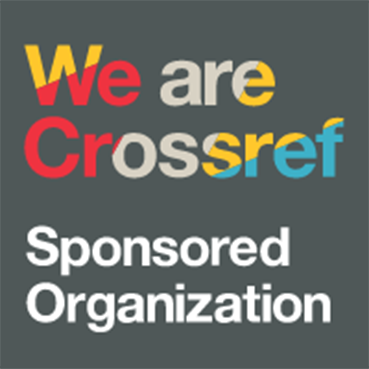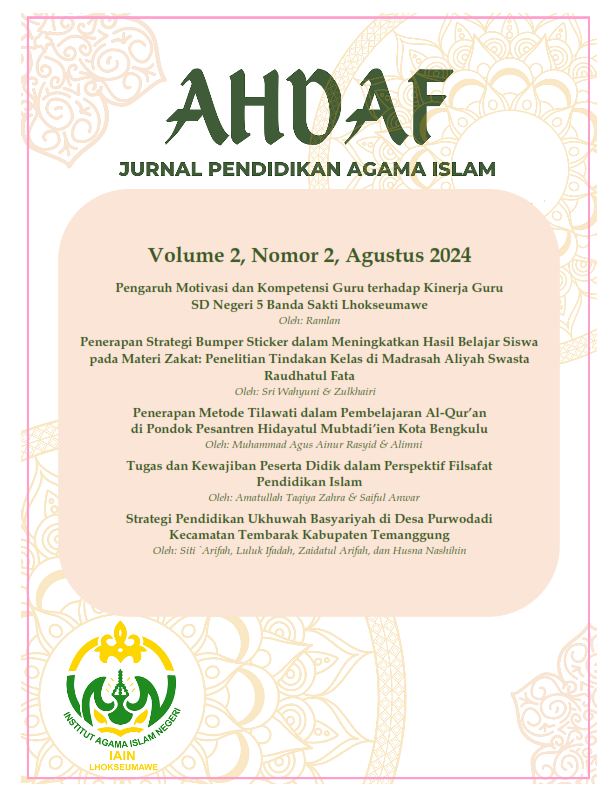Penerapan Strategi Bumper Sticker dalam Meningkatkan Hasil Belajar Siswa Materi Zakat Pada MAS Raudhatul Fata
Main Article Content
Sri Wahyuni
Zulkhairi Zulkhairi
This study aims to improve student learning outcomes on zakat material by using the Bumper Sticker strategy. This study used the method of classroom action research (PTK), which was carried out in two cycles, with the research subjects being class X students in a junior high school. Each cycle consists of planning, implementation, observation, and reflection. The results showed that the Bumper Sticker strategy was effective in improving student activeness, group collaboration, and individual learning outcomes. In cycle I, student activeness in group discussions reached 65%, which increased to 85% in cycle II. The average student score also increased from 75 in cycle I to 85 in cycle II, with the percentage of students who reached the Minimum Completion Criteria (KKM) increasing from 72% to 94%. The application of this strategy also shows that group discussions and the use of visual media (bumper stickers) can improve understanding of the concept of zakat. This study implies that the Bumper Sticker strategy can be used as an innovative learning alternative that increases students' active participation and understanding of the concepts of Fiqh material, especially zakat, and can be applied in the classroom for other topics that require conceptual understanding and collaboration.
Arikunto, S. (2010). Penelitian Tindakan Kelas, Jakarta: Bumi Aksara.
Aulia, P., Herawati, S., & Asmendri, A. (2020). Pengembangan Media Flowchart (Bagan Arus) Berbasis Microsoft Visio pada Mata Pelajaran Fikih Materi Ketentuan Zakat Kelas VIII di MTsN 6 Tanah Datar. at-Tarbiyah al-Mustamirrah: Jurnal Pendidikan Islam, 1, 1-24. https://ejournal.uinmybatusangkar.ac.id/ojs/index.php/at-tarbiyah/article/view/2494.
Brookfield, S. D. (2017). The Skillful Teacher: On Technique, Trust, and Responsiveness in the Classroom. San Francisco, CA: Jossey-Bass.
Deci, E. L., & Ryan, R. M. (2000). Self-determination Theory and the Facilitation of Intrinsic Motivation, Social Development, and Well-being. American Psychologist, 55(1), 68–78. https://doi.org/10.1037/0003-066X.55.1.68.
Fadhla, A. (2023). Upaya Peningkatan Hasil Belajar Fikih dengan Menggunakan Metode Picture and Picture pada Siswa Kelas V MIN 20 Bireuen. AHDAF: Jurnal Pendidikan Agama Islam, 1(1), 23-33. https://journal.iainlhokseumawe.ac.id/index.php/AHDAF/article/view/855.
Joyce, B., Weil, M., & Calhoun, E. (2015). Models of Teaching (9th ed.). Boston, MA: Pearson.
Kadi, T. (2023). Optimasi Peran Guru Pendidikan Agama Islam dalam Pembelajaran Fikih: Dampaknya terhadap Pemahaman Agama. ITQAN: Jurnal Ilmu-Ilmu Kependidikan, 14(2), 123–134. https://doi.org/10.47766/itqan.v14i2.1974.
Maawiyah, A., & Fauziana, F. (2023). Penggunaan Metode Variatif dengan Pendekatan Saintifik dalam Pembelajaran Fikih di Madrasah Ibtidaiyah Kota Lhokseumawe. ITQAN: Jurnal Ilmu-Ilmu Kependidikan, 14(2), 159–174. https://doi.org/10.47766/itqan.v14i2.1112.
Mayer, R. E. (Ed.). (2005). The Cambridge Handbook of Multimedia Learning. Cambridge University Press.
Miles, M. B., Huberman, A. M., & Saldana, J. (2014). Qualitative Data Analysis: A Methods Sourcebook (3rd ed.). SAGE Publications.
Nizar, M. A. K. (2023). Metode Pembelajaran Kolaboratif dalam Meningkatkan Hasil Belajar Pendidikan Agama Islam: Studi Kasus SMP Negeri 3 Lima Puluh. Community Service Progress, 2(2), 62–68. https://doi.org/10.70021/csp.v2i2.104.
Nurhayati, N. (2020). Content Analysis tentang Pembelajaran Kolaboratif Berbasis Open Ended untuk Meningkatkan Kepercayaan Diri Siswa dalam Belajar Matematika. Al-Khwarizmi: Jurnal Pendidikan Matematika Dan Ilmu Pengetahuan Alam, 8(2), 99–108. https://doi.org/10.24256/jpmipa.v8i2.857.
Peraturan Menteri Pendidikan Nasional RI No. 20 Tahun 2007 tentang Standar Penilaian Pendidikan.
Rizki, M., Afriani, G., & Zuhri, Z. (2024). Pengaruh Penggunaan Model Pembelajaran Project Based Learning terhadap Hasil Belajar Siswa pada Mata Pelajaran Fikih. AL-MIKRAJ Jurnal Studi Islam dan Humaniora, 5(01), 1733-1751. https://ejournal.insuriponorogo.ac.id/index.php/almikraj/article/view/6445.
Ryan, R. M., & Deci, E. L. (2000). Self-Determination Theory and The Facilitation of Intrinsic Motivation, Social Development, and Well-Being. American Psychologist, 55(1), 68. https://doi.org/10.1037/0003-066X.55.1.68.
Sakti, N. C., & Ainiyah, M. U. (2024). Pembelajaran Berdiferensiasi Berbasis Proyek dalam Meningkatkan Hasil Belajar Peserta Didik di Era Pembelajaran Abad 21. Jurnal Ilmiah Profesi Pendidikan, 9(2), 706–711. https://jipp.unram.ac.id/index.php/jipp/article/view/1970.
Santrock, J. W. (2018). Educational Psychology (6th ed.). New York, NY: McGraw-Hill.
Saptarina, E., Sartika, D., & Amelia, K. R. (2024). The Effect of Bumper Stickers Strategy to Improve Students’ Reading Comprehension Viewed from Students’ Reading Interest. Journal of English Education Program, 5(1). https://doi.org/10.26418/jeep.v5i1.71190.
Slavin, R. E. (1995). Cooperative Learning: Theory, Research, and Practice (2nd ed.). Boston: Allyn and Bacon.
Sugiyono. (2019). Metode Penelitian Kuantitatif, Kualitatif, dan R&D. Bandung: Alfabeta.
Vygotsky, L. S. (1978). Mind in Society: The Development of Higher Psychological Processes. Harvard University Press.




